February 20, 2007
Chicago Thaw

Looking over the bridge on LaSalle Street, 2/19/07
Despite the inauspicious beginning it was a lovely trip.
I saw the Saturday and Sunday matinées at the Joffrey. The long version will be in Ballet Review, the short version is it was worth the trip, and the alternate version lives here – Franklin, a fellow knitter and blogger was my companion on Sunday. He provided excellent company!
I saw several other good friends and got more sense of the city – what’s to get a sense of, it’s a grid, right? Yeah, and so are New York and San Francisco. Chicago’s grid has the added benefit of forcing you to memorize the early presidents in order.
Before going to Chicago, on David B’s recommendation I read Devil in the White City, a book that runs the parallel courses of the Columbian Exposition in Chicago in 1893 and Dr. H. H. Holmes one of the first serial killers who used the fair as a lure for victims. It bills itself as pure history; historians I know roll their eyes when that is said. There’s plenty of research in the book; there’s also plenty of conjecture. It’s You Are There history.
The author, Erik Larson, is better on the Fair and its architects than he is on Holmes. It’s probably a good thing, but he has an easier time making more comprehensible men such as Daniel Burnham and Frederick Olmstead come to life than a psychopath such as Holmes who is fascinating in a grisly way, but ultimately reads as a cardboard cutout villain.
That said, Larson does some great things in this ripping yarn. The conjunction of the two plot threads isn’t just historically correct; Larson teases out the opportunity and energy in both Chicago and fin de siècle America that fed both builders and madmen. It’s a portrait of a city and a country that rings true. Larson also pays special attention to architecture that opens your eyes. It could also be that my friends David B. in Chicago (whom I just visited) and David S. who just moved to Atlanta from San Francisco are an architect and a landscape architect respectively. I found myself noticing the lampposts on Madison Avenue as my bus moved uptown on the way to Boston, and staring upwards at cornices and molded decorations.
Larson’s book captures one of Chicago’s most vigorous architectural periods; a trip downtown will bring you face to face with some of the buildings described, except, alas, the World’s Fair itself. What remains of it is far to the south; David took me there on my first visit to Chicago. My hotel (the Club Quarters Central Loop – gotten again on Priceline for $68/night) is right next to the Rookery, which housed the firm of Burnham and Root. Go to see the Joffrey Ballet at the Auditorium Theatre and you are in Adler and Sullivan’s masterpiece. To cap it off, go up the stairs in the Art Institute of Chicago towards their phenomenal Impressionist collection. There is an exhibit of fragments of ironwork and moldings from buildings designed by these very architects. You really are there.
After lunch with David on Monday, as he said with satisfaction the first day above freezing in Chicago in more than a month, I had two hours to kill before heading to O’Hare, and they were profitably spent at the museum. With only that length of time, I decided to see only the Impressionist and American collections, but that means one sees Caillebotte’s amazing scene of Paris in a drizzle, Seurat’s La Grande Jatte and van Gogh’s haunting and claustrophobic picture of his room in Arles. The American collection has Hopper’s brilliant Nighthawks and the iconic American Gothic, a painting that's a good deal better than the image that resides in everyone's imaginations. It was an excellent farewell to a vigorous city.
And to make mischief . . . Franklin looks very hot in leather.
⟨skips merrily away&rang
Posted by Leigh Witchel at 10:59 PM | Comments (1) | TrackBack
February 2, 2007
The Lost Night
I finally read a book!
With the sort of irony only possible after writing a post on travel knitting, my size 8 needle that I was using for David’s scarf splintered at the join. I had John’s socks to work on as well, but chose instead to read the book I had packed, The Lost Night by Rachel Howard.
The book is a memoir of Howard’s childhood and the murder of her father one night when she was ten. She saw her father as he was dying; the murder has never been solved.
Though the mystery hangs over the book, finding out "who done it" is beside the point. Everything that happens in life, good and bad, is part of you. Howard’s story is a poignant journal of integration, of taking the unthinkable and admitting that it happened, and that it affected her irrevocably.
Place is often character. Her descriptions of the flat, hot Central Valley region in California are claustrophobic in their suburban minutiae of developments and malls with no urban area to anchor them. The murder isn’t the only violent act in the book. There’s suicide and child abuse; Howard brings the Central Valley to life, paradoxically as something that sucks the life out of people, in such a way that it seems somehow complicit in the misfortune.
The first half of the book is harder to read than the second, mostly because Howard’s detached, almost breezy style (the book is a very fast read given the subject) mirrors her own attempts during childhood and adolescence to glaze over the event as well. When in the narrative Howard is ready to start facing what happened, the tone changes imperceptibly from glossy to porous.
There is no catharsis in the book, not even in the meeting with her father’s last wife, who was there in the house along with her son and Howard on the night of the stabbing. There is integration, which may be less literary, but it’s more honest. Somehow, going back to these places as an adult may not solve anything, but it lets you go on.
Rachel is a colleague and a friend, which added a strange twist to the book. A self-centered observation, but it’s awkward to discuss autobiography with a friend afterwards. What to say? Rachel and I are due to have lunch on Sunday, so when we spoke today I complimented her on the book and mentioned how difficult it was to read something like this and know a friend went through it. For her part, she briefly said it was a long while ago – also true. Writing gives things immediacy and also exorcises some of the passion. The book is worth reading, especially for anyone who grew up in that area – even though I grew up in a completely different suburb in another state a few years earlier, there were wincing twinges of recognition.
Posted by Leigh Witchel at 10:22 PM | Comments (0) | TrackBack
September 19, 2006
Culture, cheap.
Thanks to Flygirl555 at Flyertalkfor this one.
The Smithsonian Institute is sponsoring a free museum day on September 30 and museums across the country are participating. You can look on an interactive map to see what museums in your area are participating, then print out a card to admit two people for free. So take someone you like to a museum. Culture is good.
If I were in Pasadena, California, you can bet I would be hopping right over to The Bunny Museum.
If September 30 isn’t a good day to go and you’re in NYC, many museums have a period set aside for free admission. For MoMA and the Morgan Library, it’s Friday night. Sunday morning at The Frick Collection is pay what you wish.
I blogged about the Fall for Dance Festival at City Center last year. It’s back and tickets are going fast – October 3 is already sold out. I can’t go to most of it due to schedule conflicts, but there is something for everyone each night. I’d love to finally see Trisha Brown’s Set and Reset, being done the first two nights. So get your tickets before they’re gone.
Posted by Leigh Witchel at 5:23 PM | Comments (0) | TrackBack
August 26, 2006
Thank you Messrs. Olmstead and Vaux (and good art too!)
For Central Park
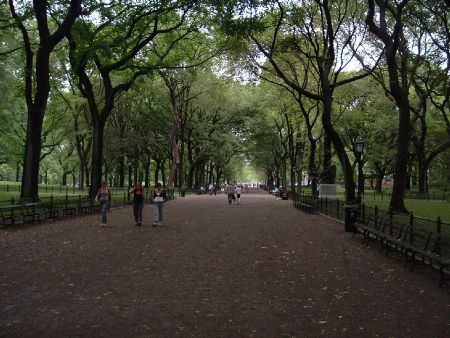
The Mall. It was a gray day, but that meant everything seemed greener.
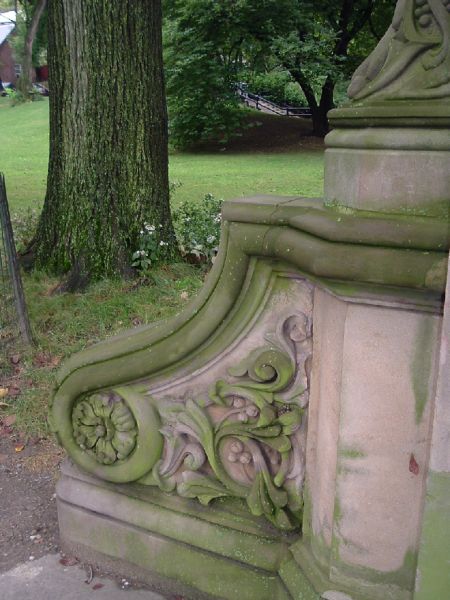
Even the stone work.
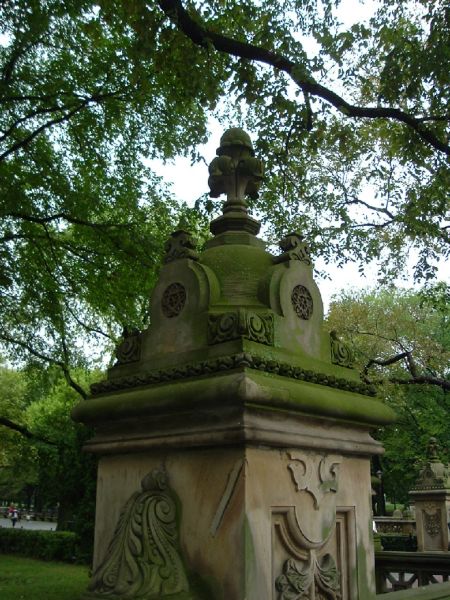
I was walking through the park this morning on the way to the Metropolitan Museum, where my friend Matt and I spent the afternoon. We both marveled at the efficiency of the visit. Usually visits to that vast hulk of a museum involve a lot of getting lost and aimlessly wandering. This time, we headed straight up the stairs and hit the exhibition of Rembrandt drawings and etchings first. Walking out of that brought us right to his objective for the visit, the Raphael Colonna Altarpiece. From there, we headed out to the Impressionist collection - right down the hall and looked at the Greatest Hits - Monet's Rouen Cathedral series, Seurat's Circus Sideshow, Vuillard, Toulouse-Lautrec, Van Gogh. From the impressionist area we went through the Great Hall (the Islamic art has been relocated there while its exhibition area undergoes renovation) and into the Chinese galleries, where we both gawked at the massive Buddha painted on the side of a wall and wondered how they got it to the museum. The Astor Court - a Chinese scholar's garden had him staring at the woodwork and me marveling at the calmness of the architecture. From there, we both went nuts over the Japanese screens, particularly a comparatively modern one of morning glories that looped right back to the Impressionist paintings we had just seen.
From there, as a lark, we looked at the Anglomania exhibition of traditional and "transgressive" fashions set in period rooms, which was insubstantial in comparison but fun nonetheless (albeit crowded). Heading to the exit, we finally got lost. It isn't an afternoon at the Met without getting lost once.
Matt and I make excellent museum companions; we both move at about the same pace when looking at art so one of us isn't racing ahead or lagging behind. We also know each other's taste very well, and it's been interesting to watch both of our taste evolve and influence each other. Matt helps me appreciate the offbeat; I get him to appreciate the more classical. We passed a small drawing Rembrandt made of the execution of a young woman on a gibbet; I knew he was going to love it - sure enough I was right.
Ironically, I had gone with Valerie the night before to the Morgan Library, where many of the same Rembrandt etchings (though often in subtly differnt versions) were on display - it is the 400th anniversary of his birth.
The Morgan is free on Friday nights after 7 p.m., and the collection is very high quality - medieval art, books and manuscripts and early religious art including reliquaries and ciboria. It's not crowded, the museum is a lovely setting (although a bit aggressively brand spanking new still - it seems all atrium in its new design that moved the entrance from 36th Street to Madison Avenue). A great way to spend a friday night, and free, to boot.
Posted by Leigh Witchel at 9:56 PM | Comments (0) | TrackBack
May 20, 2006
Watching Music
I went with a friend to Carnegie Hall a week ago to see Mitsuko Uchida play Mozart piano works. I go so frequently to dance and infrequently enough to music concerts that the differences in performance conventions are fascinating and disorienting.
Carnegie Hall is elegant, decorated with ornate gilt moldings but restrained for its time – there is enough white space on the walls to still feel uncluttered and airy. The hall is more intimate than the State Theater and at least the lower rings have an old fashioned system of box seating rather than rows. The absence of an orchestra pit changes the dynamic between the stage and the house. Without a pit as a buffer zone, the stage ends and the audience begins.
The performance has less ritual or ceremony than dance – or it could be that the rituals don’t look like rituals to me because they’re not familiar: The house lights do not dim and there is no real stage lighting; the soloist comes out onto the unadorned stage through a door unconcealed at the side of the stage. She bows to the audience and sits. Uchida was not one to waste time; the moment she sat, her hands went to the keyboard, there was an intake of breath and she began.
It was hard for me to even get through the first piece, the Fantasie in C minor K475, because of the adjusting I had to make. It’s music. What was I supposed to watch? With an orchestra there is motion on the stage; the players often trade melodies or movements cascade and ripple through the string sections like wind through wheat fields. Even though our seats were quite good, a solo piano recital at Carnegie Hall is not the same as in a salon. I couldn’t see Uchida’s face clearly and besides her fingers, not much moved. Because the lights were up, I often watched the audience watching.
At intermission I had several questions that betrayed my own background:
There’s no director, is there? Is there anyone besides a stage manager backstage?
Does she rehearse at all on stage? Is anything “staged”?
What instrument were the sonatas designed for? (A pianoforte.)
What does she do during intermission? (It’s painfully practical for dancers – if you’re a woman, you’re readying your shoes for the next ballet. Otherwise, you’re either resting or getting ready for the next piece, but the intermission is essential for the dancers as well as placed there to give the audience a respite)
The minutiae were fascinating to me. Barry explained that for concerts here the pianists did not play a “house” piano. Most of the time, they went to Steinway (a short distance away) and tried out one of many pianos that were there to find the one that sounded and felt best to them. That piano was then delivered to Carnegie Hall for the performances. The production details were a handle to the music itself, which was marvelous, but as with opera I would need more consistent exposure to be able to discuss it properly. I thought it was interesting that the first half of the program was much darker in tone than what I associate with Mozart and Uchida purposefully took a Romantic reading.
Watching music without dance reminded me what I like most about music with dance: choreography fixes music in time. When I was listening to the concert I felt like I was floating in a becalmed and featureless sea. I knew I was in the water, but did not know where I was headed. With dance, music becomes a journey that has a beginning, middle and conclusion.
When I’m at home listening to music, it is a private act done on my terms. I listen attentively or do other tasks. I back the music up and repeat. I play only my favorite parts if I choose; it's up to me. Music in a theater is a more ancient, communal experience, just like dance – yet dance does not transfer well enough to recording to have gone through the transition music made from a communal to a private art. I’m glad dance didn’t frankly, one of the reasons I’m mostly uninterested in recording technology for dance. I don’t want dance to leave the theater.
Uchida played an extremely brief encore (probably Webern) before a more traditional and contemplative one that was a lovely way to send us into the night. There was nothing but a piano, a soloist, an audience and Mozart. I need more experience and training in the zen of watching music.
Posted by Leigh Witchel at 11:58 PM | Comments (2) | TrackBack
March 31, 2006
“We are full of feelings that we cannot understand”
I saw Don Giovanni at City Opera last night; the first opera I’ve been to in a while. I enjoyed it very much but wasn’t enamored of the production; my companion who has more experience in opera also agreed the acting was flat. The production never got beyond the singing to the characters or the story. Character issues abound in the opera. Like Albrecht in Giselle, Don Giovanni has to have the audience’s sympathies. Donna Elvira needs to reconcile her contradictions; Don Ottavio’s impatience needs to be more than horniness. The best way to do this is the same as in ballet. The singers need to know and believe in the story.
The big eye opener for me was facing the conventions of another art form. From the operas I’ve seen, da Ponte and Mozart seemed to have a formula for a well-made opera both musically and structurally. There’s a celestial trio in the first act, which closes with a sextet. The tenor gets at least one slow aria that shows off his legato but grinds the story to a halt. The lyrics to the arias are fascinating because they go beyond a soliloquy to a narrative to the audience of the interior state. “My heart is broken, yet I still feel pity.” “We are full of feelings that we cannot understand.”
I find Giselle or Swan Lake far more moving than Don Giovanni. Why? Because I know the language and conventions of ballet so that form has meaning. The way a woman rises on to pointe; how a man gives his hand to his partner – there’s as much information there to me as in a paragraph. In San Francisco last month, Muriel Maffre did a tendu in Yuri Possokhov’s Magrittomania that looked like no one else’s in the world. Her simple motion of her foot to the side was a small tale all on its own. I don’t understand opera in that way: to be able to interpret a singer’s approach to a note the way I can interpret a ballet step. All I have is the plot. A good reminder that ballet looks like secret code to even the educated audience that hasn’t seen it before.
Posted by Leigh Witchel at 6:47 PM | Comments (0) | TrackBack
February 21, 2006
Tempus Fugit (II)
On both directions of a subway ride the other day I started a conversation with a handsome young man reading a book. It didn’t hurt that they were handsome, but it was the books I was interested in: Gravity's Rainbow and Private Domain
. The man reading Gravity’s Rainbow was the older of the two, probably 26 or 27, and worked for a literary magazine. He was within the first few pages from the beginning; I jokingly asked if he knew what he was getting into.
I read Gravity’s Rainbow in the summer of 1979, the summer before I went to college. I was 15; I didn’t get most of it. I told the young man that it helped to have a solid background in physics and that there were formulas as part of the novel. “Yeah, but they weren’t real?” he asked. No, I averred, Pynchon studied physics at Cornell – more accurately, he studied engineering physics, but completed his degree as an English major after his Naval service.
We talked about writing classes. He didn’t believe in them; I understand why, but said I had a few very good teachers (Geoffrey Woolf) as well as some dreadful ones (Alice Walker – the worst teacher I ever encountered). When I mentioned reading books to prepare for St. Petersburg he mentioned Ryszard Kapuściński’s Imperium; I’ll check it out.
Heading back home, a young man trundled into the subway car and sprawled open-legged on the seat. He pulled out his book; when I noticed Private Domain I had to comment once more. “It’s a great book, but don’t forget that you can’t trust him. He’s like Ford Maddox Ford, what he says may or may not be true.” He smiled; he was planning to audition for the company so he wanted to read it.
I wished him luck and refrained from mentioning that he’d probably need to bulk up to get into Taylor. We got to talking. He got his training in college in Maryland, had been here for a year. Medium height, slender build, pretty hair, bright eyed and bushy tailed. He was taking class at Cunningham, so we played the “do you know” game – but we didn’t really know the same people – his favorite teacher at the studio is Jeff Moen.
“I’m in 10:00 am class at Cunningham every day so if you’re ever around . . .” I laughed. I stopped taking class in 1998 and my body stopped hurting. When I was studying at Ballet Arts with Jan Miller, Nina Stroganova used to teach class before hand, one that was frequented by many older dancers from the Ballets Russes and other companies. There was tons of amazing history in that class that went foolishly unexplored, but they looked ridiculous to us – they weren’t dancers, they were old people who could barely lift their legs. I promised myself that I would stop taking class before I looked like that.
It’s funny to see books I read as a student being read by new students. It’s funny to talk to a young dancer with his career in front of him pointing to the unknown. Those books, those boys and their place in time remind me of where I am presently suspended in time – not old, but no longer young.
Posted by Leigh Witchel at 11:41 PM | Comments (1) | TrackBack
December 3, 2005
Beauty Immobile
My friend (and costumer) David Quinn celebrated the one-year anniversary of his boutique with a showing of his Holiday collection at Location One.
Alas, I took no pictures but I hope he will have them on his site soon. The stuff was wonderful as usual; my favorite outfit was a trim fitted-bodice black top with a gold cobweb overshirt topping a light skirt gathered in custardy swirls. I also loved an over the top coat of ostrich feathers dyed in the colors of the collection (green, rust, white) and shot through with Lurex. An absolute show stopper, but you’d have to be 6’15” (or a pimp) to pull it off.
There’s often a stereotypical hatred borne out of jealousy assumed of gay men or drag queens for women. Debs has never been a body fascist and I think that’s because of his empathy with the dilemma of making feminine clothing look good on any body. He’s always included plus-sized models (this year the magnificent Dirty Martini). The outfit he sent Dirty out in was audacious, with a large train wrapped at the side in a bow that emphasized and celebrated her curves.
Even though Debs has always been committed to fashion for any body, there still was irony in the show. The models were squired by an entourage of black-clad men, mostly half naked. They included several talented dancers who have danced with Mark Morris, NYCB and though it ain’t in the same league, Dance as Ever. The “female” models had some men among the biological females, including the effervescent Shasta Cola in white laced top with poet sleeves and a black flapper skirt. Banu Ogan was dressed in a Victorian-inspired top that made her look like one of the Brontë sisters.
Many of the "female" models (female and otherwise) were as talented dancers as the men. But they did not dance; they couldn’t. Perched on five inch heels, they walked or had champagne brought to them by the men as they relaxed on a couch. High fashion turns you into a gorgeous, living statue. Even men’s suits do much the same thing, and much as I enjoy wearing them (all men look handsomer in suits) they’re as constraining socially as they are to mobility. I can’t bring myself to knit publicly when I’m wearing a suit; it seems as ridiculous to me as conducting business in a clown costume.
Posted by Leigh Witchel at 11:44 PM | Comments (0) | TrackBack
September 12, 2005
Out and About - Art for Free!
My weekend was filled with culture. I didn't realize the Museum of Modern Art was free on Friday evenings. Val and I went to see the Pisarro-Cezanne exhibit, which was quite crowded and then down to the even more impressive permanent collection on the fifth and fourth floors. I haven't been to MoMA in a while; there are a few rooms that you walk into and suddenly are hit with the fact you're looking at five of the most famous paintings of the last century and a half in a single room. It's quite an impact. I'll certainly go again.
Open Stitch is a working exhibition at Location One of 15 designers producing work with the materials provided to them, essentially scrap material and found objects from most from New York's most artistic dumpster diving organization, Materials for the Arts. David Quinn, the designer who has done my costumes since 1996, was participating so I went Sunday afternoon to visit. The room was half sweatshop, half fantasy factory. I loved the energy. Debs (how we all know David) was making the skirt for a jacket just finished. It had a wonderful 60's silhouette, part bolero and part peplum jacket. Debs is in the center of the picture, the dress is on the form at the front left.
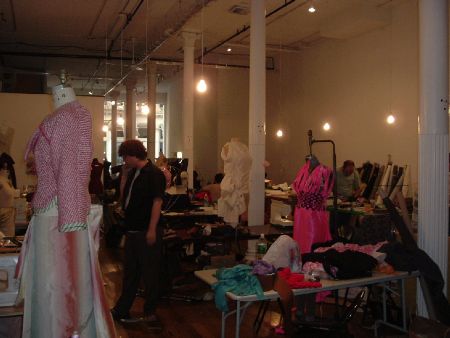
Wishing to fit in, I sat down and pulled out the Red Leaves shawl to work on. That inspired Debs to introduce me to Chris Sanders, one of the designers who is also a knitter. She brought over a shoulderette she had knit from upholstery trim she had unplied and strips of fabric on US 35 needles (for non-knitters, that's humongo-boat-oar size). It shimmered and draped marvelously.

The array of designs was the most enjoyable aspect. Chris was piecing together a carapace-like vest out of pink eyelash trim and silver relective paper. Right next to her Selma Karaca was draping a lovely dress that recalled Mme. Gres' classically inspired dresses, but in bright red. George Hudacko was using fabric strips and trim to create dress with a woven bodice.
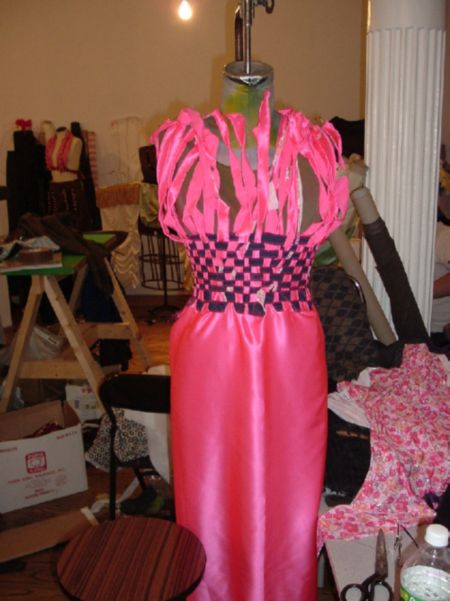
You can see it all yourself now through Wednesday from 12-6 at Location One. The nearest subway stop is the N or R at Canal. After the 13th the workspaces will be left as they were as an exhibit, and then on October 1 there will be a runway show and party. Or, you can watch the whole thing on live streaming video.
Posted by Leigh Witchel at 12:45 AM | Comments (0) | TrackBack
May 12, 2005
Another thought inspired by Darger.
Taking from my own essay's quote on Darger:
Henry Darger fulfills every romantic myth of the artist: Solitary, unbalanced, undiscovered, untrained, unrecognized, impoverished and conveniently dead, therefore available for romanticizing, analysis and exploitation.
When did we go from being more interested in an artist's works to being much more interested in his or her life? We all know it's happened, but when did it happen?
Posted by Leigh Witchel at 3:44 PM | Comments (0) | TrackBack
May 11, 2005
Henry Darger's Ghastly Innocence?
As well as my piece on Pat Graney’s The Vivian Girls, I commend to you Lisa Traiger’s report made when the work was performed in the Washington, DC area, which does more justice to the details of the dance itself than my report.
I find one sentence in Lisa’s piece especially striking:
Darger's work is ghastly at its core and strangely enticing and beautiful—its colors, its imaginings, its fantasy—on the surface.
This is completely the opposite of how I see Darger's work. To me it’s ghastly only on the surface and innocent at the core.
I think about the goriness in Darger they way I think about the Brothers Grimm, or childhood rhymes like Ring around the Rosie, which we’ve completely forgotten is about the plague. Or for that matter even Roadrunner and Bugs Bunny cartoons. The awfulness, the deaths, the two ton anvils turning Wile E. Coyote into a pancake are omnipresent and almost zestily unreal. He’s up in the next frame, laying out rope for his next trap of the Roadrunner, and this time he's going to get shredded into ribbons by rotating knives.
It’s quite possible the dismembered and hanging children in Darger’s work betray the darkness in the soul underneath. He’s not here to tell us. Is it also possible they also show a child-like innocence where the fascination with the grisly and the ghoulish is a sort talisman against it?
Posted by Leigh Witchel at 2:52 PM | Comments (3) | TrackBack
March 11, 2005
Word of Mouth - VaVaVoom Room closing
I regret being out of town for this. I have never gotten to see Serge le Gainswack. I've been friends with the alter egos of Serge and Dirty Martini for years and think the burlesque scene downtown is the most energetic in the city. Go if you can. I don't know if he is doing it tomorrow, but Tigger does a strip act as a priest that is too tasteless not to be fabulous.
THIS IS IT! Our LAST show at Fez before it closes its doors!! This Saturday March 12th our cavalcade of stars includes:Chanteuse Cou Cou Bijoux!
International Fan Dancer Dirty Martini!
Dapper Diamond Redd!
The World Famous BOB!
Dance Stylist Serge le Gainswack!
The Darling, Depraved Julie Atlas Muz!
The Ginge Minge of Tigger!
The return of Ukulele Louie!& Many More Surprise Guests!
Pianist Brooks "Babyface" Hartell and his whole band!
your Mistress of Ceremonies Miss Astrid
At Fez: 380 Lafayette St @ Great Jones doors open at 10:30 show
begins at 11pm
All tickets $18.00
Reservations:212-533-2680 OR WWW.TICKETWEB.COM
Information: 212-330-9349
www.vavavoomroom.com Your Den of Iniquity for Vaudeville and Burlesque
Voted Best Burlesque Show in NYC by New York Magazine
and everyone else on planet Earth
Posted by Leigh Witchel at 1:48 PM | Comments (0) | TrackBack
March 1, 2005
Out and About - The Gates (second visit)
I went again on Saturday. The weekend crowds made the event even more like a religious festival, or perhaps a camel market.
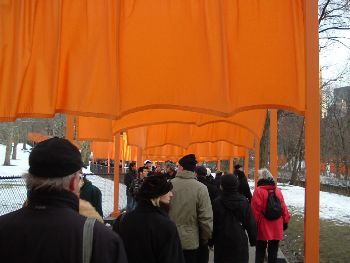
Obviously, everyone had a different reaction and experience with them, but I felt I learned most of what I needed to know about the installation in the first 10 minutes. That said, it was worth the visit and an interesting event.
Posted by Leigh Witchel at 7:37 PM | Comments (0) | TrackBack
February 24, 2005
Out and About - The Gates
I looped the long way to work today and cut through a small section of Central Park to finally see The Gates. It was only a brief excursion but worthwhile; I hope to go back on Saturday if the weather permits.
The Gates are fascinating more as an event than as artwork; people are streaming into the park to stroll through and explore them. They change the landscape of the park entirely, but temporarily; a benign flexing of humanity’s muscle to shape the earth. Perhaps it’s the color, which I associate with the robes of Buddhist monks, but the first thing that struck me when I passed under the rippling gates were the pictures my father and stepmother brought back from Tibet of prayer flags. The Gates have the same communal excitement of a religious festival, but in a secular setting.
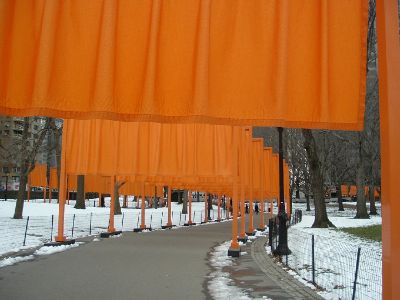
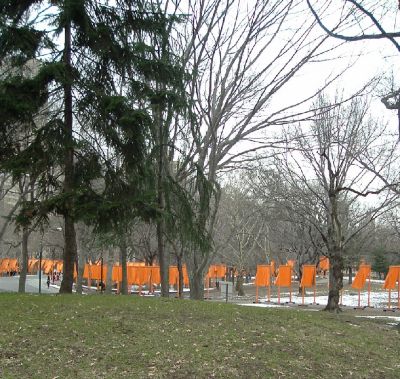
Posted by Leigh Witchel at 10:56 PM | Comments (0) | TrackBack